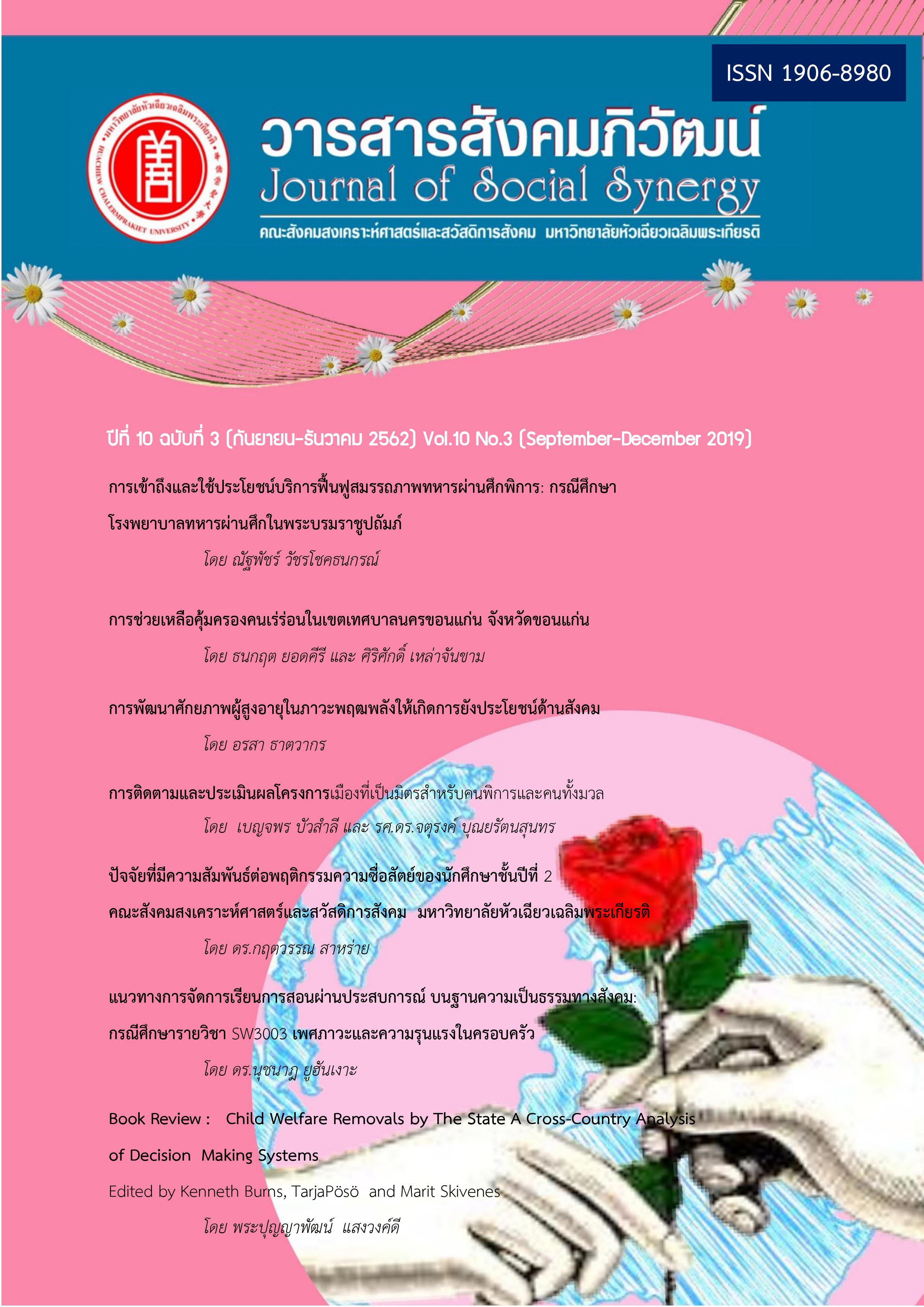Potential Development of Active Aging for Contributing to Society
Keywords:
Aging potential development, Physical and psycho-social well being, Active agingAbstract
The purpose of the study on "Potential Development of Active Aging for Contributing to Society" was three-fold: (1) to study development potential guideline of active aging, (2) to support well being of aging in physical and psychological, and (3) to support income sustainability of aging. Mixed methods were employed for the study. Data collection includes 2,520 samples, 12 focus groups discussion in the technical promotion and support office region 1 – 12, and in-depth interviewed 2 experts on aging.
The study reveals most sample groups were female, aged 60 – 69-year-old, married, finished primary school, unemployed, underlying disease on hypertension, osteoarthritis of the knee, diabetes, hyperlipidemia, and amnesia. The top three sources of income were government allowance, son or daughter, and occupation respectively. The average income and payment per month was 3,000 Baht. Saving in the bank or saving group was not over 10,000 Baht, average debt not over 50,000 Baht.
The physical well being of the sample group was moderate while psychological and social wellbeing was high. Most sample groups had a body of knowledge on agriculture, art and culture, religion, ethics, industrial, handicraft, education and ready to transfer their knowledge to the community.
Factors influencing potential development of aging composed of motivation, favorable circumstances, reward, reinforcement, and encouragement including good relationships within a family.
Guideline of support physical of aging was encouraged them to exercise while psychology support was collective action for society, self-care, and learning information technology in order to live happily in modern society
Social welfare development for aging must be based on human rights, liberty, participation, and human dignity, changing from subsidy to empowerment under the view of everyone has the right to equal opportunities.
Based on the findings, the researcher suggests the Ministry of Social Development and Human Security should be used the Center of Quality of Life Development and Occupational Promotion to implement various activities for aging. Social Development Volunteer should coordinate active aging in order to build an aging volunteer network to increase their contribution to society.
References
กุศล สุนทรธาดา และ กมลชก ขำสุวรรณ. (2553). ระดับและแนวโน้มความมีพฤฒิพลังของผู้สูงอายุไทย.
การประชุมวิชาการประชากรศาสตร์แห่งชาติ 2553 : 26-38.
จิราพร เกศพิชญวัฒนา และคณะ. (2549). โครงการพฤฒพลัง: กรณีศึกษาจากผู้สูงอายุที่ได้รับการยอมรับในสังคม
(รายงานการวิจัย). กรุงเทพฯ: สำนักงานกองทุนสนับสนุนการสร้างเสริมสุขภาพ.
จุฑาทิพย์ เล็กล้วน. (2550). ปัจจัยที่ส่งผลต่อรูปแบบการทำงานช่วยเหลือสังคมของผู้สูงอายุอาสาสมัคร
พัฒนาสังคมและความมั่นคงของมนุษย์ (อพม.) ในกรุงเทพมหานคร (สารนิพนธ์ปริญญามหาบัณฑิต). กรุงเทพฯ : มหาวิทยาลัยธรรมศาสตร์.
ยงยุทธ เกษสาคร. (2541). ภาวะผู้นำและการจูงใจ. กรุงเทพฯ : ศูนย์เอกสารและตำราสถาบันราชภัฎสวนดุสิต.
ไตรรัตน์ ทองสัมฤทธิ์. (2548). ปัจจัยเกื้อหนุนและสุขภาวะที่ผู้สูงอายุได้รับจากการเข้าร่วมทำงานอาสาสมัคร
(การศึกษาอิสระปริญญามหาบัณฑิต). กรุงเทพฯ : มหาวิทยาลัยเชียงใหม่.
นงนุช สุนทรชวกานต์. (2552). การสร้างโอกาสการทำงานของผู้สูงอายุไทย. กรุงเทพฯ : ศูนย์บริการวิชาการ
เศรษฐศาสตร์, มหาวิทยาลัยธรรมศาสตร์, คณะเศรษฐศาสตร์.
อโณทัย วีระพงษ์สุชาติ . (2541). การเสริมสร้างพลังอำนาจในงานและการคงอยู่ในงานของพยาบาลวิชาชีพ โรงพยาบาลสมเด็จพระยุพราช. เชียงใหม่ : มหาวิทยาลัยเชียงใหม่
Gibson, C. H. (1991). A concept analysis of empowerment. Journal of Advanced Nursing, 16 : 354–361.
Kanter, R. M. (1977). Men and Women of the Corporation. New York: Basic Books.
Kinlaw, D. C. (1995). The Practice of Empowerment. Hampshire, England: Gower.
Laschinger, H. K. S., and Havens, D. S. (1997). The effect of workplace empowerment on staff nurses’occupational mental health and work effectiveness. Journal of Nursing Administration 27(6): 42-50.
Laschinger, H., Finegan, J., Shamian, J., and Wilk, P. (2004). A longitudinal analysis of the impact of workplace empowerment on work satisfaction. Journal of Organizational Behavior, 25(4), 527–545.
McDermont, K., Laschinger, H. K. S., & Shamian, J. (1996). Work empowerment and
organizational commitment. Nursing Management, 27(5), 44-48.
McKay B, Forbes JA, Bourner K.. (1990). Empowerment in general practice: the trilogies of caring. Australian Family Physician 19(4), 513-520.
Puetz. (1988). Empowerment in occupational health nursing: wielding power through expertise. AAOHN Journal, 36(12), 503-507.
Rappaport, J. . (1984). Studies in Empowerment : Introduction to the Issue. Prevention in Human
Services, 3, 1–7.
Sabiston, J. A., & Laschinger, J. K. (1995). Perceptions of Empowerment and Intent to Stay: Review of Related Studies Using Kanter’s Theory. New York: Elsevier Health Sciences.
Wilson, B., & Laschinger, H. K. S. (1994). Staff nurses’ perception of job empowerment and
organizational commitment: A test theory of Structural Power in Organizations. Journal of Nursing Administration, 24(4 Suppl), 39-45.
Downloads
Published
How to Cite
Issue
Section
License
บทความที่ได้รับการตีพิมพ์เป็นลิขสิทธิ์ของวารสารสังคมภิวัฒน์ มหาวิทยาลัยหัวเฉียวเฉลิมพระเกียรติ
ข้อความที่ปรากฏในบทความแต่ละเรื่องในวารสารวิชาการเล่มนี้เป็นความคิดเห็นส่วนตัวของผู้เขียนแต่ละท่านไม่เกี่ยวข้องกับมหาวิทยาลัยหัวเฉียวเฉลิมพระเกียรติ และคณาจารย์ท่านอื่นๆในมหาวิทยาลัยฯ แต่อย่างใด ความรับผิดชอบองค์ประกอบทั้งหมดของบทความแต่ละเรื่องเป็นของผู้เขียนแต่ละท่าน หากมีความผิดพลาดใดๆ ผู้เขียนแต่ละท่านจะรับผิดชอบบทความของตนเองแต่ผู้เดียว




